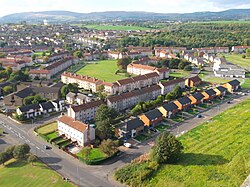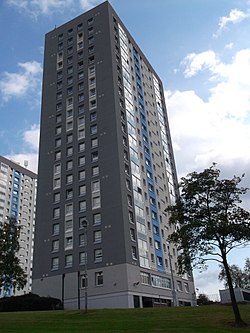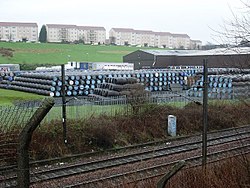Drumchapel
| Drumchapel Gaelic: Druim a' Chapaill | |
| Dunbartonshire | |
|---|---|
 Drumchapel houses | |
| Location | |
| Grid reference: | NS525705 |
| Location: | 55°54’18"N, 4°21’39"W |
| Data | |
| Population: | 12,976 |
| Post town: | Glasgow |
| Postcode: | G15 |
| Dialling code: | 0141 |
| Local Government | |
| Council: | Glasgow |
| Parliamentary constituency: |
Glasgow North West |
Drumchapel is a suburb of the city of Glasgow, located in the parish of New Kilpatrick, Dunbartonshire. It borders Bearsden to the east and Clydebank to the west. The area is bordered by Knightswood and Yoker in Glasgow. The name derives from the Gaelic meaning 'the ridge of the horse'.
As part of the overspill policy of Glasgow Corporation, a huge housing estate was built here in the 1950s to house 34,000 people - it is this estate that is now most associated with Drumchapel, despite there being an area known as Old Drumchapel made up of affluent villas to the south of modern Drumchapel.
The area had well-known social problems, notably anti-social behaviour and degeneration of often poorly constructed post-war housing. However, it remains popular with many of its residents and more recently there has been substantial private investment in the area, leading to the construction of new housing developments in the North West of the district. The area, along with Easterhouse, Castlemilk and Greater Pollok are collectively known as 'Big Four' post-war social housing schemes. All are similar in terms of architecture and planning, and tend to suffer from a similar range of social problems.
The area is served by Drumchapel railway station.
History
Drumchapel is part of the ancient and civil parish of New Kilpatrick, and became an ecclesiastical parish in its own right in 1923. The Old Church (originally serving both Drumchapel and Blairdardie) was built in 1901 for an increasing local population.[1] The parish boundary was redrawn to create the new parish of St Margarets in Knightswood.[2]
Drumchapel was annexed by Glasgow Corporation in 1938.
Geography

The housing in the area is now 72% post-war tenement and 6% multistorey flats, the remainder being other flats and houses. The current population was estimated in 2002 at 15,000, which was split into 6,000 households.[3] The population of Drumchapel fell by 22% between 1996 and 2012 to 13,000. The proportion of people in the area from minority ethnic groups increased over the same time to 5%, which remains well below average for Glasgow (12%). Life expectancy in the area is about five years less than the average for Glasgow (male 69 years, female 74 years).[4]
Socio-economically, the area is not affluent. In 2011/2012, 48% of children were classed as living in poverty, and 57% of the population were NRS social grade D or E. 56% of households were single-parent. 21% of young people were not in education, employment or training. Just 22% of the population own their own home, about half the average for Glasgow.[4]
Economy
The major employers for Drumchapel from the 1950s to the 1980s were the Goodyear Tyre & Rubber Co (GB) Ltd, Beattie's Biscuit Factory, Singers Sewing Machines - Clydebank, The Reo Stakis Organisation - Hills Hotel and Rigg Public Bar, The Golden Garter Night Club and The Butty Public Bar, The Edrington Group Whisky Bond and the various shipyards on the Clyde. Beattie's Biscuit factory closed in 1978 and the Goodyear and Singers factories both closed in February 1979. Reo Stakis's Hills Hotel and Rigg Public Bar along with The Golden Garter Night Club closed in June 1988.

The Edrington Group Whisky Bond has grown over the years and is still a major employer in the area while the shipyards have all gone with the exception the now BAE Systems yards at Scotstoun and Govan. Drumchapel is now going through its second regeneration with promises of better schools, better homes and higher employment.[5]
References
- ↑ Kilpatrick Parish
- ↑ McCardel, J (1949). The Parish of New Kilpatrick. University Press Glasgow.
- ↑ Glasgow City Council: Drumchapel Area Housing Plan 2002
- ↑ 4.0 4.1 "Drumchapel". Glasgow Centre for Population Health. http://www.understandingglasgow.com/profiles/3_nw_sector/31_drumchapel. Retrieved 16 March 2015.
- ↑ The History of Drumchapel
Outside links
| ("Wikimedia Commons" has material about Drumchapel) |
